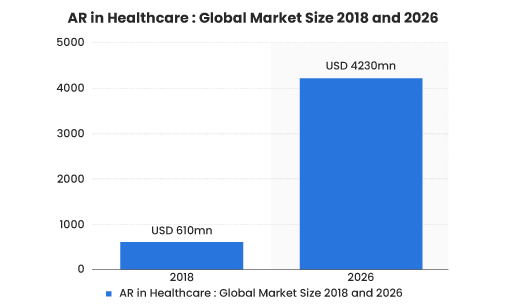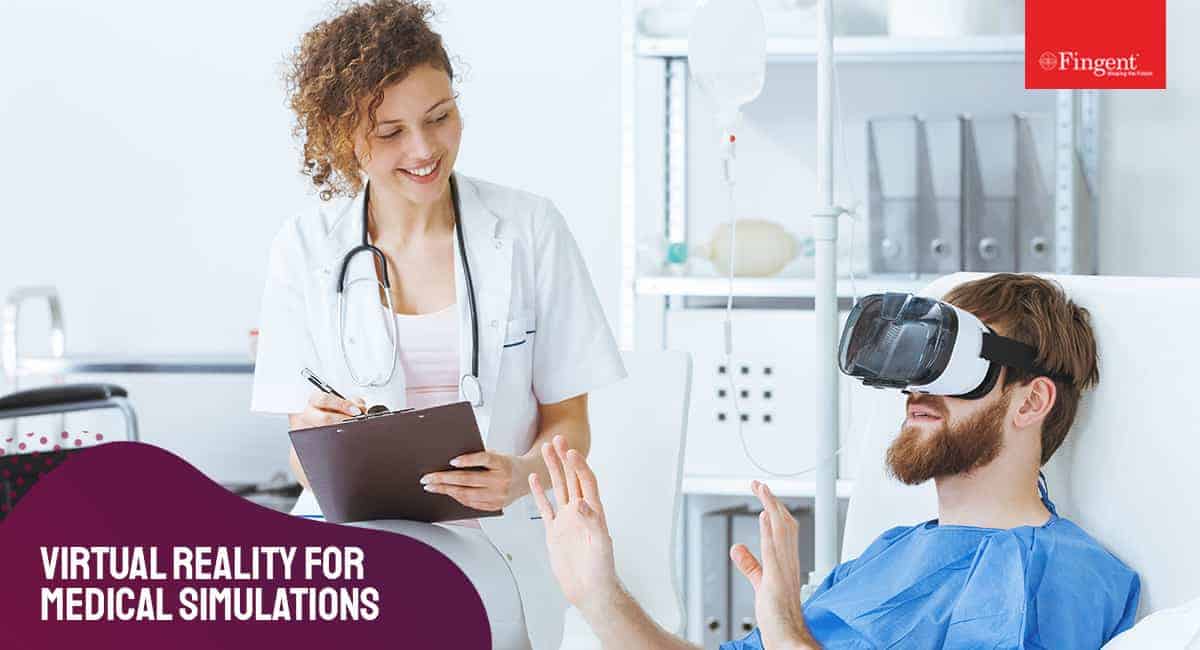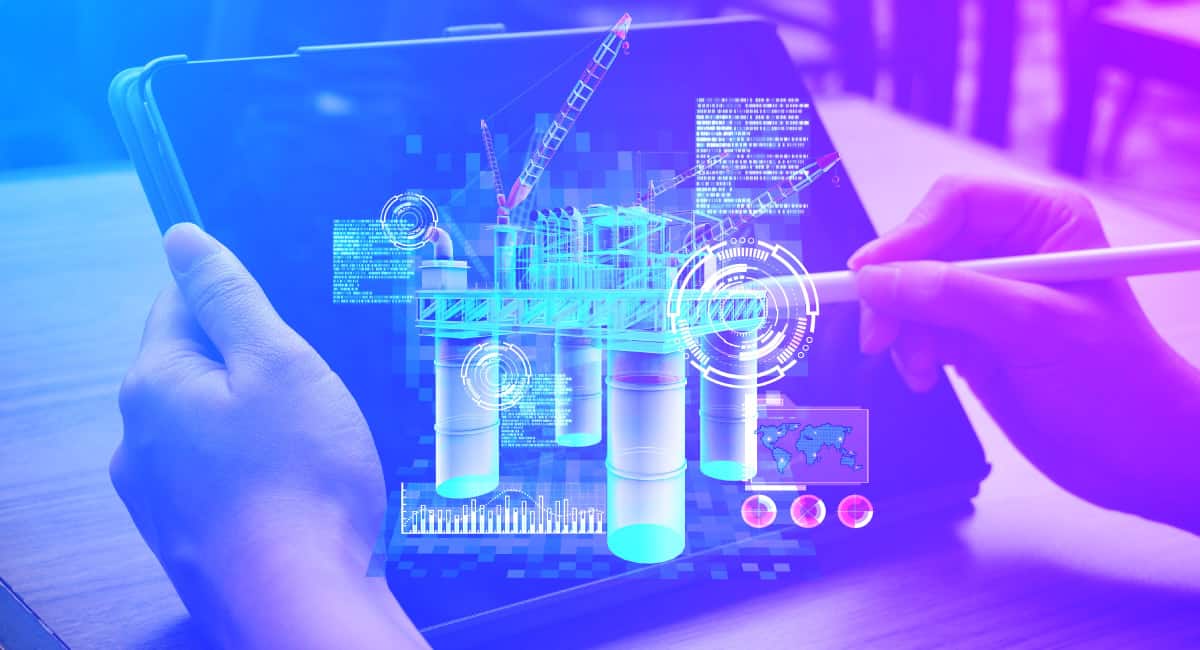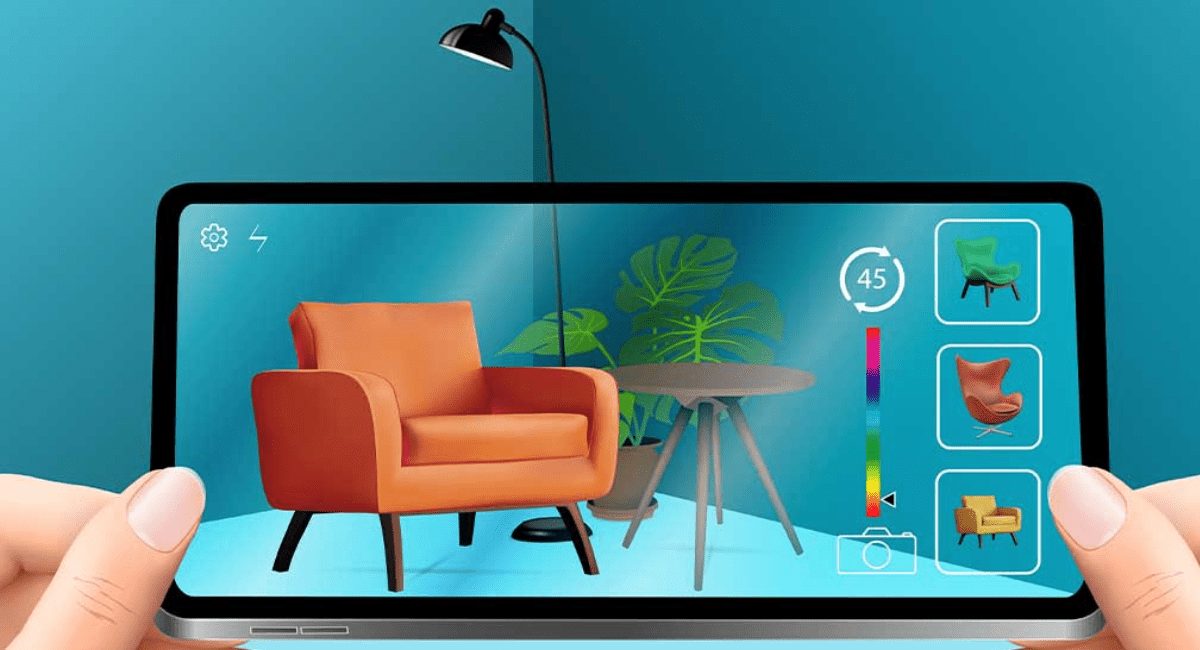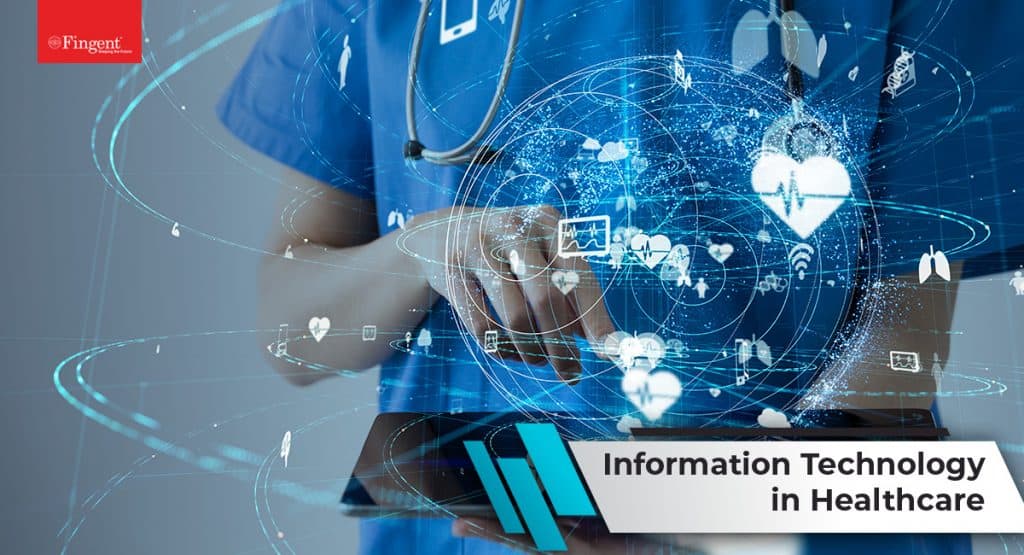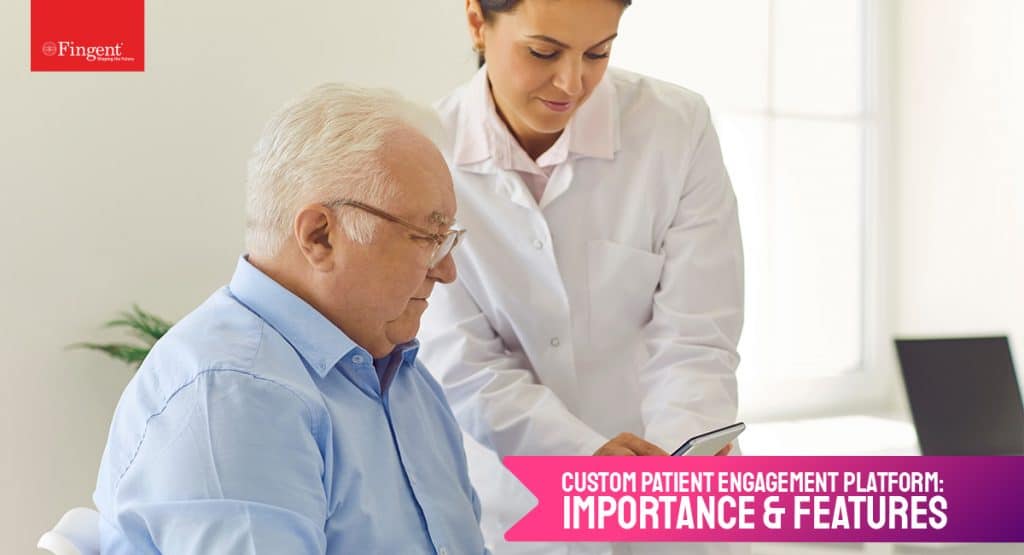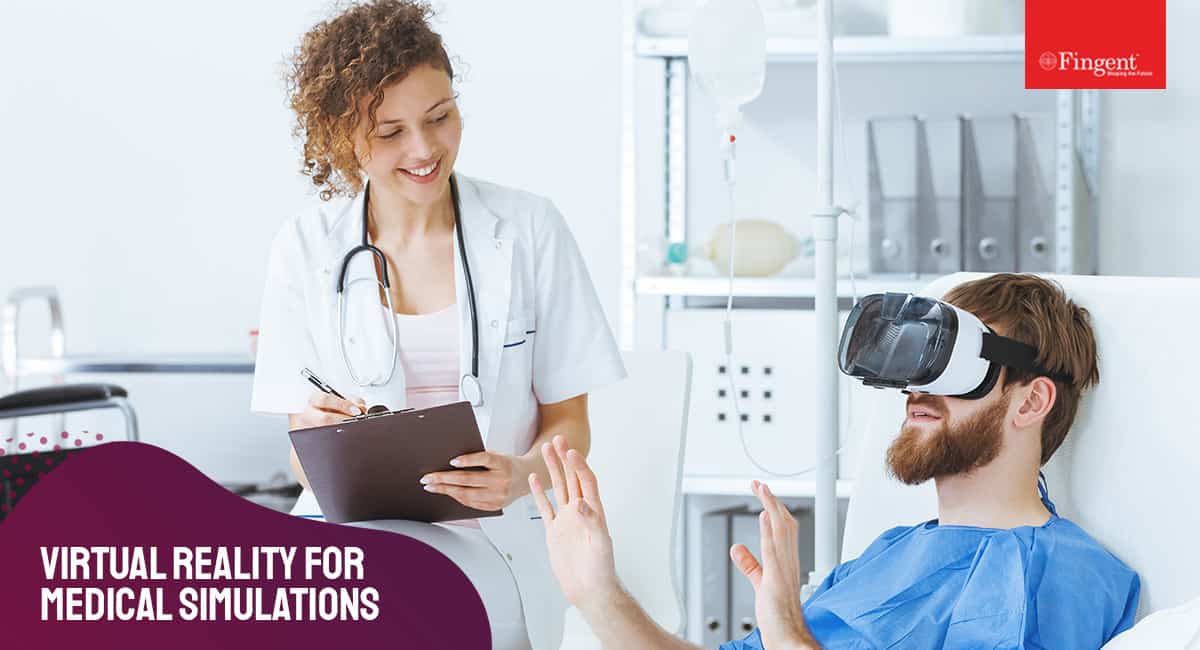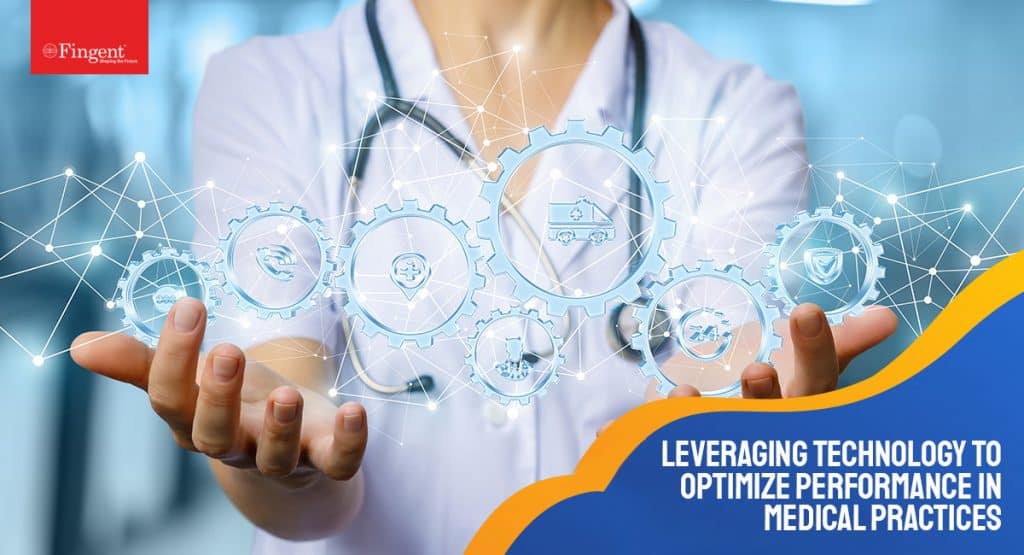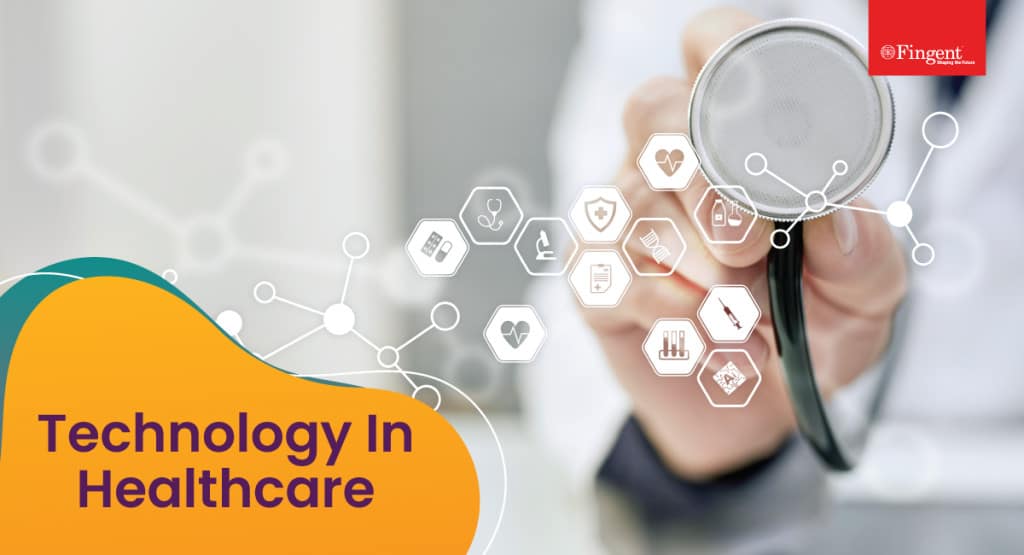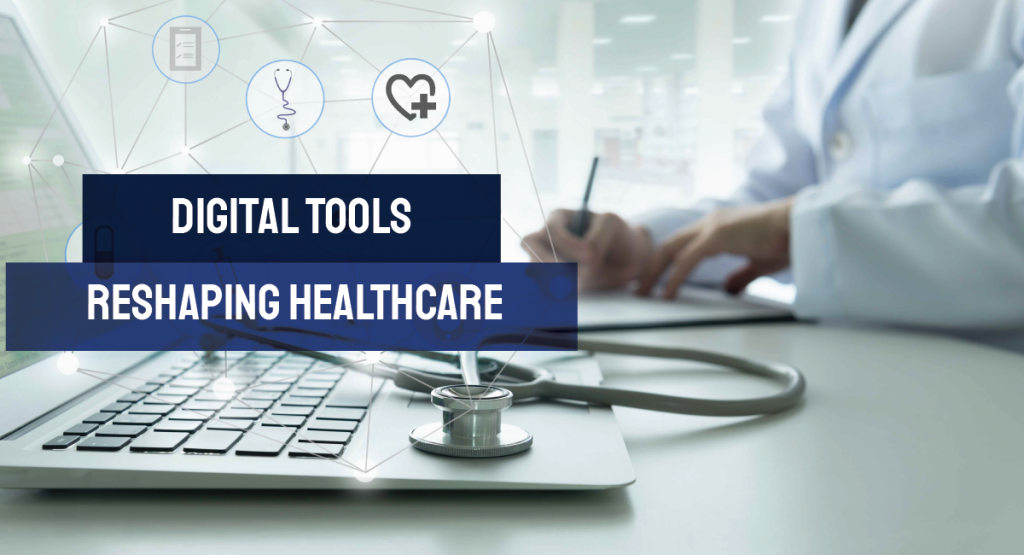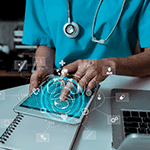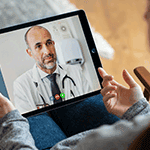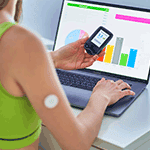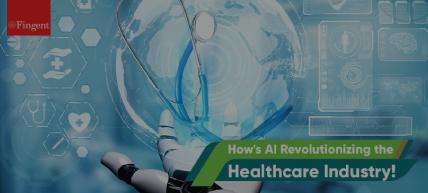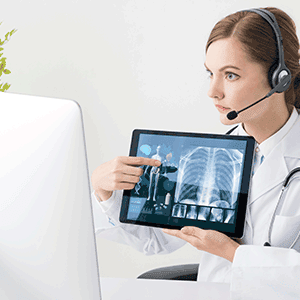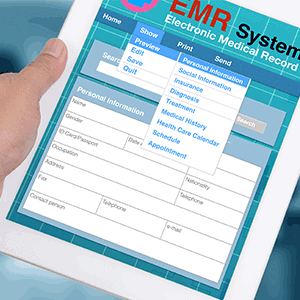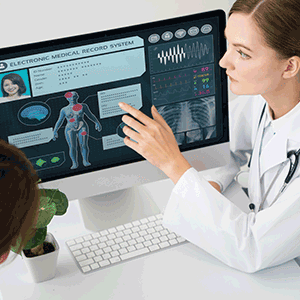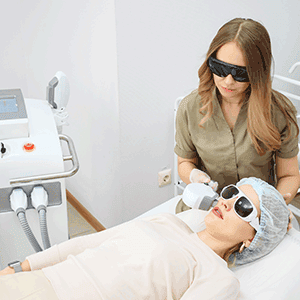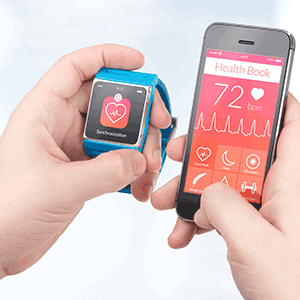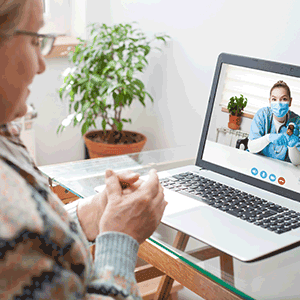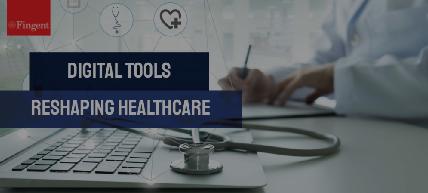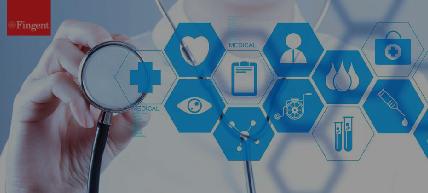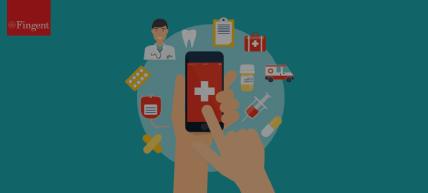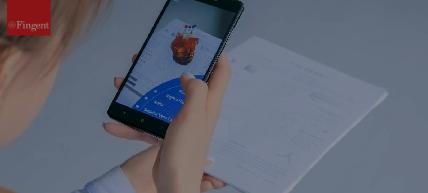Tag: healthcare
Stay up to date on what's new

Featured Blogs
Stay up to date on
what's new



Talk To Our Experts
Top Healthcare Digitalization Trends To Look For In The New Normal
Healthcare digitalization is reshaping the way we interact with healthcare professionals, share medical data or make decisions related to treatment and outcomes. There are plenty of examples that substantiate the digitalization of healthcare today, such as Artificial Intelligence-powered medical devices, telemedicine, blockchain, remote-patient monitoring, and electronic health records.
The main aim of healthcare innovation is to streamline the medical professionals’ work, optimize medical software systems, reduce human errors, improve patient outcomes, and lower costs through integrated web and mobile experiences.
Read more: The Application and Impact of Information Technology in Healthcare
Let’s look at the state of healthcare digitalization in 2024 and beyond:
1. On-demand Healthcare Will Grow
With the COVID-19 pandemic restricting many people to remain indoors, more and more patients seek on-demand healthcare. It is convenient as it helps patients seek guidance at their own time and from anywhere they need it.
DMN3 reveals that patients obtain online medical information primarily for the following reasons:
- 77% for booking medical appointments
- 47% for searching information about doctors and healthcare professionals
- 38% for searching information about hospitals and medical facilities
That said, on-demand healthcare is rising due to the growth of the gig economy. Here, freelance professionals from various industries hire themselves out per job or ‘gig’ instead of sticking to one company.
Read more: Patient Engagement Platforms: 7 Must-have Features
Many online healthcare marketplaces link doctors directly with short-term tasks, making it easier for physicians to deliver patient care in specific circumstances based on their expertise and schedule. Simply put, doctors are becoming on-demand healthcare providers to meet the changing needs of their patients in a better way.
2. Big Data Will Be Used To Improve Healthcare Management
Big data is the information gathered from various platforms such as eCommerce, social media, online transactions, and financial transactions. It helps identify patterns and trends for future use.
Read more: 5 Ways Big Data is Changing the Healthcare Industry
For healthcare, big data offers benefits such as:
- Reduced medication errors: Patient record analysis allows the healthcare software to flag any inconsistencies between a patient’s health and drug prescriptions. This alerts the health professionals and patients in case there is a potential risk of a medication error.
- Simplifying preventive care: Many recurring patients stepping into emergency rooms are “frequent flyers.” These frequent flyers account for up to 28% of clinical visits. Big data analysis helps identify these recurring patients and create preventive plans to keep them from returning.
- Improved staffing: Using big data’s predictive analysis, hospitals and clinics can estimate future admission rates enabling these facilities to allocate proper staff to deal with the patient. This will help save money and reduce emergency room waiting time, especially when a facility is understaffed.
Case Study: How did a data analytics solution help NHS gain financial, clinical, and geographical insights to improve visibility over their KPIs? Read Now!
Big data analytics, visualization, and insights generation can improve healthcare operations management and transform the patient experience.
3. Virtual Reality Will Transform Medical Training & Care Delivery Models
Virtual Reality is one of the most outstanding healthcare digitalization trends that change the way patients are diagnosed, and medical residents are trained.
- VR in medical diagnosis & treatments: VR is increasingly used in treatment segments in healthcare, such as patient education, robotic surgery, physical and psychological therapy, etc. For instance, medical professionals can use VR to construct a 360° patient-specific video detailing how the surgery will help the patient cure and the consequent results. Virtual Reality has been found effective in treating anxiety, post-traumatic stress disorder, and stroke.
Case Study: Find how Fingent developed a unique mixed reality application for a leading university that enables users to identify people using facial recognition. Download Now!
- VR for medical training: Other uses of VR technology include doctors and medical residents using VR simulations to hone their skills (learning in near-real situations) and safely plan complicated surgeries. In addition, VR headsets are used post-surgery to encourage patients to exercise and follow physiotherapies. The technology also enables autistic children to learn and navigate the world.
- Growth of VR in the medical field: From startups to established pharma companies, everyone recognizes the role of VR in healthcare. Experts estimate that by 2025 the global virtual and augmented reality in healthcare will reach $5.1 billion market value. So, if you’re a healthcare company wanting to improve your digital marketing strategy, you should consider investing in VR.
Read more: How Virtual Reality Improves The Standards Of Medical Education And Training
Virtual Reality technology offers a powerful communication channel that allows you to understand customers’ needs better and virtually engage them with your products and services.
4. Wearable Medical Devices Will Enjoy A Wider Market
Another major healthcare digitalization trend is companies collecting their health data from medical devices such as wearables. Previously, most people would check in with their doctors only when something went wrong and were used to undergoing physical check-ups once a year. However, technology is changing that. Today, people highly focus on preventive maintenance and are interested in knowing about their health status frequently. This trend forces several healthcare companies to invest in wearable technology devices that allow patients or family members to track health vitals and seek medical aid when needed. Wearable medical devices enable up-to-date monitoring of high-risk patients and determine the likelihood of any severe health risk.
Experts estimate that the wearable medical device market value will cross USD 27,200 mn by 2023.
Following are some of the widely used wearable devices:
- Exercise trackers (Google Fit, Fitbit, etc.)
- Heart rate sensors (Samsung Heart Rate Sensor, Pulse Sensor, etc.)
- Sweat meters: to monitor blood sugar levels of diabetics
- Oximeters: to monitor the amount of oxygen carried in the blood
Wearable devices in healthcare offer the following benefits:
- Personalized healthcare experience: Medical devices help patients improve their health and give them a sense of ownership regarding personal healthcare management.
- Insurance pricing: Wearable devices provide insurers with insights that enable them to rate a patient’s risk for illness more accurately.
- Insurance incentives: Wearable devices allow patients to take preventive measures to improve their health. Such patients are more likely to obtain lower insurance premiums.
- Gamification opportunities: Fitness watches can help create competitive goals for users to achieve through diet, nutrition, and exercise.
Case Study: Read more about how Fingent helped create a fitness Regimen app for trainers.
5. Healthcare AI Investments Will Increase
By 2025, the healthcare AI-enabled tools market is expected to exceed $34 billion globally. This indicates that healthcare AI investments will peak soon as Artificial Intelligence is set to transform various segments in medicine.
AI-powered chatbots and virtual health assistants fulfill many roles in the healthcare industry, such as customer service representatives, diagnostic tools, or even therapists. Hence AI in healthcare is gaining immense popularity. According to a report published by MarketsandMarkets, the global healthcare chatbots market is estimated to reach $314.3 million by 2023.
Read more: 5 Leading Chatbot Use Cases Explained with Real-life Examples
That said, we can witness the real power of AI in diverse areas such as medical imaging, drug discovery, precision medicine, and genomics. For example, the first-ever drug designed by AI is showing some promise to help patients suffering from obsessive-compulsive disorder. The AI-made drug molecule, DSP-1181, is in clinical trials currently. Researchers and scientists expect that the use of AI will make drug development faster and more efficient.
Overall, AI is projected to bring USD 150 billion by 2026 in annual savings for the US healthcare economy. As start-ups are lapping up the opportunity, the number of active AI start-ups has increased 14 times since 2000.
Why Keep A Close Eye On These Healthcare Digitalization Trends
These five healthcare digitalization trends will spill over in the future as the industry will innovate and adapt to meet the patients’ demands. As a result, organizations that embrace healthcare digitalization will see dividends sooner.
Fingent top custom software development company, helps you navigate the digital healthcare space and adapt to the ‘Next Normal’ with our transformative experiences. Our custom healthcare software solutions have helped many of the leading healthcare providers worldwide. Contact us to learn more about how your healthcare organization or clinic can leverage healthcare digitalization effectively.
Stay up to date on what's new

Featured Blogs
Stay up to date on
what's new



Talk To Our Experts
Custom patient engagement platforms improve caregiver-patient interactions today. Here’s how.
With the COVID-19 pandemic restricting face-to-face engagement, patients have started using telehealth (telemedicine) technology and other digital channels to receive healthcare services. The growth of digital healthcare will increase the demand for healthcare technologies in the future. 81% of people (patients) want healthcare providers to know them individually and deliver more personalized and meaningful experiences.
While support programs like teleconsulting do not replace the physical presence of healthcare providers, they offer valued information, which is the need of the hour. With stay-at-home mandates, social distancing, and lockdowns, telemedicine is the vital care model that boosts patient engagement today. Personalized patient engagement fosters trust among patients and ensures continuity of care. So, in times of pandemic and beyond, patient engagement platforms will play a crucial role.
Read more: 5 ways to optimize the revenue of your medical practice and clinical processes
Patient engagement and its growing significance
In simple terms, patient engagement is a concept where patients are actively involved and considered important decision-makers in their care.
Engaged patients are:
- Informed- as they understand their health status and the treatment.
- Empowered- as they believe they can change their health outcomes.
- Heard- as they can communicate with their providers better and participate in shared decision-making.
What is a patient engagement platform (PEP)?
A patient engagement platform is an application that enables patients to interact with healthcare providers via their mobile device, tablet, or computer. The patient engagement platform keeps the patients involved beyond the four walls of the hospital.
When implemented effectively, patient engagement platforms can help streamline access to medical records, provide appointment reminders, enable self-scheduling for patients, and deliver patient education or awareness.
How do patient engagement platforms help?
Patient engagement platforms (PEPs) can help automate the following processes.
- Send reminders to patients regarding their postoperative treatment protocols
- Allow patients to update mobility reports and pain score
- Deliver educational content
- Manage images of wounds
- Record and monitor health vitals like BP, FBS, BMI, etc.
Read more: 7 major impacts of technology in healthcare
What are the benefits of a patient engagement platform?
1. Ease the patient engagement process
A customized patient engagement platform helps improve your patient experience by assisting them in scheduling medical appointments. It can also help notify patients about their next visit to the clinic, or when they need to check their health vitals, or when their current medication course will be over. In addition, caregivers can use the patient engagement platform to track a patient’s medical history and use the data to channelize treatment plans when the patient pays a second visit.
2. Enable caregivers to focus on core competencies
With a patient engagement platform in place, patients can fill in medical forms, electronically scan their insurance cards, and consent from their mobiles, laptops, or computers. It will allow healthcare providers to focus on their core competencies and saves patients from standing in queues or long wait times. In addition, it can expedite the care delivery process during an emergency.
Case Study: Fingent partnered with Casenet’s Advanced Solutions Group to develop TruCare Insights as a reliable population health management platform. Download Now!
3. Empower care providers to make informed decisions
Healthcare organizations can use information like satisfaction scores, online appointments, wait times, and ROI to make informed decisions related to staffing and identify opportunities for improvement. Custom patient engagement platforms allow clinicians to track all this information effectively. It goes a long way in supporting clinical decision-making.
4. Optimize healthcare throughput
Patient engagement platforms allow online registration that ensures patients have less waiting time in the clinic. It enables healthcare providers to attend to more patients in a given time and improve data accuracy and demographics. In addition, patient engagement platforms spare medical professionals from time-consuming and manual data management processes so that they get time to receive advanced medical training. Nurses, physicians, administrators, and other hospital staff members can streamline their communication, increase staff satisfaction, and utilize data analytics to make strategic decisions.
Benefits to the patients:
- Patients are aware of the next steps, such as diet plans, exercises, medication plans, or next clinical visit
- Consistent and transparent care will be available 24/7
- Augmented patient engagement and experience
- Improved communication lowers preoperative stress and anxiety
Case Study: How did a data analytics solution help NHS gain financial, clinical, and geographical insights to improve visibility over their KPIs? Read Now!
What to look for in a custom patient engagement platform?
Given the changes in patient behavior, expectations, and changing healthcare landscape, healthcare providers will have to ramp up patient engagement strategies and implement the latest engagement technologies. Patient engagement platforms must enable providers to determine the best ways to deploy their expertise and services to their patients.
Read more: Digital tools reshaping the healthcare industry
So, make sure the patient engagement platform has the following capabilities.
1. EMR integration
The patient engagement platform should integrate with Electronic Medical Records (EMR). For example, the platform should receive data from the EMR, such as a referral or recall, and revert to the EMR.
2. Sentiment analysis
The main aim of patient engagement is to understand patients on a deeper, emotional level. So, it is crucial to leverage sentiment analysis technology. This will enable providers to recognize when a patient is happy or frustrated and respond accordingly.
3. Real-time and interactive patient communication
The platform must encourage bidirectional communication, specifically text-based messaging. In short, patients must be able to communicate with their health system easily.
4. Chatbot functionality and keyword actions
The use of chatbots and keywords in patient engagement platforms is trending. It helps reduce human intervention. So, the patient engagement platform should allow for automated responses to common questions such as “where are you located?” The platform must also enable keywords to trigger automation, such as scheduling a ride for patients who need a lift.
Read more: 5 leading chatbot use cases explained with real-life examples
5. Patient on-boarding
The platform should drive patients to the patient portal and help them register quickly and conveniently to get medical support on time.
6. Integration with other vendors
A single app can’t solve it all. It is just not feasible and is also not in your patient’s best interests. Make sure that your patient engagement platform integrates seamlessly with your other vendors. For example, the platform can offer billing features or even integrate with medical billing software, medical invoice management software, etc.
7. Boost employee adoption
Your staff must like and accept the patient engagement platform. If they don’t appreciate the new technology, it won’t fulfill its potential. In addition, you must ensure that the patient engagement platform enjoys enterprise-wide adoption and has a user-friendly UX and UI.
8. Offer multilingual support
As not all patients speak English, you will have to ensure that the platform supports different languages used or spoken widely by your patients.
Read more: 5 essentials to an effective healthcare application
Why should you adopt a custom patient engagement platform?
A custom patient engagement platform is specifically developed for your organization to cover your unique healthcare requirements and cater to your internal processes.
As such a platform is built from scratch, it gives you the freedom of choice for technology. Additionally, you can easily integrate this platform with third-party systems because you get to control the code entirely. Also, you will have full ownership of the final product and customize the software according to any relevant changes in your organization.
Benefits of a custom patient engagement platform
- High scalability
- Seamless integration to your existing infrastructure
- Enables integration with any new services you are willing to include in your medical practice
- Freedom to choose the technology
- Gain full ownership of the resulting solution
Custom patient engagement platform is best suited for medical practices that:
- Offer a wide range of services
- Plan to expand in size and services
- Have rigid workflows that are difficult to adapt
- Want to integrate the new solution with the existing system
Read more: The application and impact of information technology in healthcare
Develop your custom patient engagement platform with Fingent
At Fingent, we have the expertise and work closely with you to build a custom patient engagement platform to suit your business needs. Our software development experts help you select the best web development frameworks, database and backend technologies, data visualization formats, and leading front-end technologies to develop your patient engagement platform or any medical software that you would require.
Fingent helps you develop healthcare application platforms tailored to your needs, with top features like appointment scheduling, medical billing, patient feedback management, payment processing, chatbot, and fundamental to in-depth analytics. To know more, please get in touch with us.
Stay up to date on what's new

Featured Blogs
Stay up to date on
what's new



Talk To Our Experts
Technologies that help optimize revenue and performance of your medical practice
There’s no denying that revenue is essential for any business. Sustained revenue flow keeps the employees paid, leaves the doors open, and the patrons happy. It is the same for medical practice as well. However, it can be challenging to optimize medical practice revenue and increase avenues to bring in more money. It is crucial to find strategies that the medical practice can maintain over time to ensure a steady cash inflow.
Additionally, as the COVID-19 pandemic continues to influence patient behaviors, it is pushing healthcare practices across the globe to re-evaluate their business operations and look for solutions that emphasize clinical efficiencies, improve patient revenue cycle management along with enhanced reporting and analytics tools.
Apart from the challenges related to the patient intake process during the pandemic, healthcare providers also have had to meet the sudden demand for virtual care by embracing digital healthcare technologies. Advanced technology in healthcare helps automate major processes, facilitate patient engagement efforts, and improve financial stability.
In this article, we share tips to optimize the revenue of your medical practice.
1. Robust financial management
Strong finance is the foundation of every business. You must consider what money is going out in the form of overhead costs, payroll, and miscellaneous expenses. Look for ways to cut unnecessary expenditures and save your practice some money.
There are chances that you are spending on something unnecessary at your practice or experiencing a small ROI due to a huge yet incompetent investment. If a service is not bringing you a good ROI, you should remove it. To overcome these issues, ensure you have a robust revenue cycle management system in place.
Custom RCM systems help improve the administrative and clinical functions associated with claims processing payments and revenue generation. The RCM system also facilitates the financial processes of identification, management, and collection between patients and providers. RCM helps you optimize your revenue cycle at all the points of the financial process. This enables you to collect and increase revenue whenever and wherever you should.
2. Leverage healthcare information technology
While the initial cost and ongoing investment may vary based on your practice, most of the following technological investments will help you save money and increase your revenue over time.
Read more: 7 Major Impacts of Technology in Healthcare
Example 1: Telehealth
Technologies like telehealth offer safer alternatives to in-person visits. With the ongoing pandemic, this technology helps provide safe care by connecting via virtual video visits. If your practice can allot for more appointments, then telehealth allows for more visits throughout your day.
Additionally, patient portals, self-check kiosks, and QR codes help reduce the risks of exposure and increase scheduling flexibility and clinical availability. Remote patient monitoring (RPM) helps bring about organizational resilience and stabilizes patient outcomes with better and safer alternatives to in-person visits.
Example 2: Appointment Management Systems
Most medical practices lose revenue due to no-shows, missed appointments, or late cancellations. Appointment management systems ensure that patients are notified well ahead of their appointment times. This will eventually provide your practice with a better chance of fulfilling appointment times and retaining revenue. It will also improve patient trust and credibility and allow your medical staff to stay organized at work.
Example 3: Practice Management System
This system includes all your appointment scheduling, billing, patient registration, claims processing, clearinghouse integration, and more. So, investing in an intelligent practice management system can bring billing in-house and retain previously claimed revenue from outsourcing.
Read more: Digital Tools For The Future Of Healthcare Providers
3. Intuitive reporting and automation
An Electronic Health Record(EHR) system includes an array of innovative tools that can significantly impact your practice’s productivity and profitability. The EHR technology should also have tools that offer flexible functionality and interactive engagement in addition to simple record keeping so that you can focus more on patient care and waste less time on troubleshooting staff errors or reconfiguring documentation notes.
Additionally, automated workflows, comprehensive reporting features, and insightful productivity metrics help simplify your practice’s workload and streamline task management. Picklists allow you to create templates, line-item defaults and define column choices so that information is readily available and easily accessible.
4. Optimize your medical billing
To maximize your medical practice’s revenue, you must include efficient and personalized medical billing software. It allows you to optimize the bills according to the prevalent industry standards. Most practices bill patients at allowable lower levels to avoid being audited. While you may not get audited, the practice leaves behind a lot of money. So, when you provide clinical service, make sure to document it properly and bill customers appropriately. Medical billing software makes auditing easy and relieves your admins from revenue management challenges. The software also ensures that your billing and coding staff are not making mistakes, leading to significant claims denial.
If claims denials, coding errors, or any other billing issues keep your practice from optimizing the income, you may consider building customized software to handle your organization’s specific challenges. Fingent specializes in developing customized medical billing software and healthcare application platforms by working closely with your medical practice. It allows you to lower denial rates, reduce errors, and streamline your revenue cycle.
5. Security and compliance
When it comes to healthcare, efficiency matters not just at the surface level but in every single aspect of treatment, including financing, scheduling, and reporting. To ensure your EHR can keep up with the regular system, it should include an educational database that allows providers to quickly train their staff and give the patient access to explanatory articles and videos. Keeping these resources available will help bring about positive outcomes and hassle-free software maintenance. Fingent offers custom software development, testing, implementation, maintenance, and support services for healthcare service providers. We’ve partnered with organizations like NHS to help them improve clinical process management using technology.
While compliance laws ensure patient health information (PHI) and overall safety of practice operations, you must make cybersecurity a top priority. This is especially true now with the shift to working remotely. Employees are more prone to hacker’s attempts to cease connectivity and steal confidential data. To overcome this, you must use virtual private networks (VPN) and reliable firewall software to safeguard vital business information. Our network security and IT infrastructure management services ensure that your business-critical assets are protected from cyber threats, and your proprietary information is protected 24/7.
Read more: The Application and Impact of Information Technology in Healthcare
Advanced technology in healthcare has helped providers choose and select a system that benefits their business. For example, medical billing software, revenue cycle management, appointment management, and patient engagement systems are a few solutions that providers should consider when employing an EHR solution. Healthcare technology improves patient resolutions, avoids preventable errors, and expands clinical availability.
Practice is a step ahead of theory. Our healthcare IT system developers follow this rule of thumb. Connect with our team to learn more about the technologies you can adopt to gain business benefits and significant cost savings.
Stay up to date on what's new

Featured Blogs
Stay up to date on
what's new



Talk To Our Experts
Stay up to date on what's new

Featured Blogs
Stay up to date on
what's new



Talk To Our Experts
Stay up to date on what's new

Featured Blogs
Stay up to date on
what's new



Talk To Our Experts
How e-commerce adoption benefits B2B healthcare providers and device makers
The healthcare and life sciences industry is expanding at an exponential rate. The complexity and regulatory nature of the industry have made it imperative that technology catches up with its pace and offers solutions to meet this expansion. This need is being felt more acutely at the moment with the COVID-19 pandemic on the loose. As the pandemic spreads its poison and puts the B2B healthcare and life sciences e-commerce market into a state of flux, it forces large and small organizations to cope with a range of problems that include difficult purchase decisions, supply chain disruptions, and fulfillment and delivery issues. This calls for a technological solution tailored to suit the B2B healthcare and life sciences industry.
With over 17 years of experience in delivering customized technological solutions including developing e-commerce platforms for B2B clients, we provide B2B e-commerce web application development services for manufacturers, wholesalers, distributors, and so on. Also, our mobile app development services specialize in the designing and development of custom B2B e-commerce apps.
Case Study: Fingent’s solution for our client Bonanza – Streamlining Online Listing and Inventory Management
In this article, we will explore five specific ways in which B2B e-commerce is that solution and how it will transform healthcare and life sciences.
Immediate and lasting impact on the B2B e-commerce market
In the present scenario, especially from a healthcare and life sciences manufacturing and supply perspective, the impact is immediate throughout the entire supply chain. Manufacturing companies are unable to keep up with the demand, and distributors are rushing to create workflows in an attempt to mitigate customer complaints. Distributors are being forced to claw their way to the front of the line to obtain supplies from manufacturers, stock up on products, and take care of their customers.
Healthcare and life sciences organizations typically have disaster preparedness plans, but dealing with such an unprecedented disaster is another ball game altogether. The question has shifted from purchasing to inventory, from buying to stocking. It makes it challenging to find the space to hold extra products that these industries may need and that causes anxiety to all parties within the supply chain.
B2B e-commerce offers irresistible opportunities for purchasers and medical suppliers
B2B e-commerce works largely on a distribution-based model where customers get their supplies from local distributors or dealers. Thus far, e-commerce has been disrupting the offline system of the B2B industry at a slow pace. However, with the spread of coronavirus and the subsequent lockdown, various industries including healthcare and life sciences are switching to online buying options to prevent human contact. This has resulted in B2B e-commerce experiencing an unprecedented boost in traffic and sales in just a matter of a few weeks.
Read More: Contactless Retail Delivery Software – How Retailers Can Revive Sales While Adhering To Social Distancing Norms
While buyers turn to an online purchase, many suppliers have adapted their strategy to foster online sales, dedicating a certain amount of their budget to digital marketing and communications. The current pandemic is imposing digitization of all B2B businesses that would help to communicate with the buyers and generate sales. Digitization of the supply chain is a crucial aspect of e-commerce because it encourages transparency and shows real-time availability of goods right from the manufacturers to the buyers. This makes it extremely important for suppliers to implement digitization in their supply chain.
The present COVID situation has forced most suppliers to work from home. Those who have already been using digital media are able to manage work remotely. However, others need to think over and plan to reform their business model to adapt to the new era of e-commerce. The pandemic might be temporary, but this trend is not going to be! This is a breakthrough that will continue far into the future. Now is the best time to be innovative, leverage the benefits of the latest digital technology, data analytics, and AI and unlock the potential of digitalization and e-commerce in B2B business. An advanced e-commerce solution built on the latest technology facilitates seamless interactions online across marketing, product discovery, sales, and post-sale service in the B2B sellers’ space.
Read More: E-commerce ERP Software
Five ways B2B e-commerce can be transformative
As B2B e-commerce forges ahead, the healthcare and life sciences industries will prove to be faster adopters than others. They can fully leverage real-time data tracking inventory and logistics between buyers and sellers. For manufacturers and distributors who sell to hospitals and nursing homes, the level of information presented to buyers in the B2B space can depend on the size of the organization or the customer that is doing the transaction. Depending on the frequency of the order, the level of sophistication of information may vary. Shifting to B2B e-commerce will prove to be a much-needed transformation.
Here are five ways that this transformation will be seen:
1. Online Shopping Drives Online Presence
E-commerce is changing the way people and end-users (such as doctors) shop for healthcare products and the way those products reach the hands of customers. Instead of visiting a pharmacy, most customers are turning to the internet to perform the functions of a regular pharmacy. Healthcare and life sciences companies use a business model that features quick delivery to a patient’s door or to hospitals and healthcare centers. Investors see promise in this revolutionary approach to medication fulfillment, demonstrating that the market has confidence in this model despite the shifting healthcare and life sciences landscape.
With more and more people turning to the internet to access products and medical care, the healthcare and life sciences industries have been increasingly concerned with the quality of their online presence. According to an online medical marketplace, 50% of their customers are referred by their primary provider or by hospital staff, and 20% are referred by family or friends. This highlights the need for the healthcare and life sciences industries to increase their online presence and maintain it.
2. Helps explore new possibilities while cutting costs and time
Shifting to an online B2B e-commerce process can help businesses recover 25-30 percent of their investment. Some of the more mature players might even see higher returns of their business through online orders.
Migrating more orders online frees up time for sales reps. They can concentrate on introducing new products and capitalize on opportunities for new business. This allows industry leaders to use their time and ability to explore new channels of business and revenue streams. This can also help expand their client base and move into new markets.
B2B e-commerce enables the healthcare and life sciences companies to see where the business is coming from, where the segments are online and where they are offline. It also gives them the ability to offer variable discounts with certain customers, on certain products, or even just one customer. It will make drug prices more transparent and market-oriented.
Read more: Odoo E-commerce – 5 Reasons to Integrate Your E-commerce Application with Odoo ERP
3. Transforms Logistics Operations
Synchronization of logistic operations is critical for the success of any business. Enterprise customers generally look for reliability, speed, traceability, and convenience in delivery along with effective product returns, and exchange policy of damaged products.
Technology solutions for B2B e-commerce provide orchestration with an application that is to be hosted on an e-commerce website. The open standard in these applications facilitates information exchange that allows real-time visibility for seamless integration across supply chain stakeholders. E-commerce offerings can provide credibility and trust for transactions between companies involved in the supply chain.
4. Enables Customer Personalization
B2B e-commerce enables customer personalization. Enterprise customers want personalized solutions. B2B e-commerce provides a customer portal with content organized around the parameters of their past purchase history and price optimization algorithms that are adjusted on the basis of the relationship. E-commerce offerings are simple, flexible, and convenient. B2B players can use a comprehensive suite of tools that are available to help their customers navigate the site. Certain platforms incorporate live online support to assist with any queries or issues which can improve conversion levels and facilitate buying decisions.
5. Sheer Momentum
Many medical device companies are already selling products online to enterprise customers. The healthcare and life sciences market is ripe for disruption. Medical device manufacturers and pharmaceutical companies will continue to deliver to wholesalers and distributors, but e-commerce allows them to embark on direct-to-patient delivery. Logistics is ready to respond with tailored services for various products. B2B e-commerce is set to propel healthcare and life sciences forward in the extremely near future.
Take Action
Ultimately, healthcare and life sciences e-commerce will facilitate the redistribution of stakeholders’ offline enterprise transformation and reconstruct all the links of the value chain. Realizing the benefits of B2B e-commerce, many healthcare and life sciences companies are becoming believers.
Read more: Top 5 Open-source ERP Systems for Medical Equipment Suppliers
E-commerce can effectively optimize operating processes, reduce costs, manage resource allocations, and address the increasingly diversified consumer healthcare demands. The healthcare and life sciences companies must understand that due to the conditions of accelerated technology change, it has become critical for enterprises to become more skilled in deciding their future course and be firm in taking action. If you need help with this, we are software development experts and are here to help you take that next step. Get in touch with us and just let us know what you need.
Stay up to date on what's new

Featured Blogs
Stay up to date on
what's new



Talk To Our Experts
A list of 5 popular open-source ERPs that support healthcare equipment suppliers
The global healthcare expenditure is anticipated to rise at a CAGR of 5% till 2023. The healthcare industry can, therefore, look at a bright future. Medical equipment suppliers have to deal with various challenges. They have to ensure that all products comply with the regulatory guidelines, are of high quality, and are entirely traceable. Robust ERP systems can help medical equipment suppliers to gather insights from data to make quick decisions. Let’s take a look at some of the open-source ERP systems out there that are suitable for SMEs.
1. Odoo ERP
Odoo is an open-source ERP platform that allows ease of deployment. This is specifically helpful for SMEs that do not have dedicated IT infrastructure. The flexibility helps integration of different business processes and systems. Odoo for medical equipment suppliers is a comprehensive ERP solution that helps manage financials and operations with ease.
The core modules of Odoo like Accounting, Project Management, and Inventory Management make it suitable for medical equipment suppliers. Developers can create custom third-party apps to meet the specific needs of a medical equipment supplier. Odoo offers more than 10,000 apps to meet most business needs. Fingent is an official partner of Odoo with years of experience in implementing, customizing, and providing consultation for clients. As an Odoo development company, Fingent has catered to the needs of various customers and streamlined their operations. Our motto of increasing efficiency and ease-of-use has made us a popular choice among various organizations for Odoo implementation requirements.
Read more: 5 Salient Features of Odoo that Make it a Reliable ERP for Enterprises
2. ERPNext
ERPNext is a contemporary ERP solution that allows you to focus on delivering medical equipment of high-quality by effortlessly managing your supply chains. It enables you to intelligently track orders, monitor stock levels, implement promotions, and minimize errors in inventory sourcing. You can leverage the numerous built-in integrations offered by ERPNext and start supplying in no time. With ERPNext, you can have real-time updates on the movement of equipment, control equipment transfers within different warehouses, and generate required reports quickly and easily. You can also create your customized software on-the-fly without any code.
3. Epicor
Medical equipment suppliers have to deal with difficult delivery timelines, complicated pricing arrangements, unique inventory, oversee seller agreements, and concessions. Epicor ERP solution enables you to carry out all your operations with ease. The Epicor Prophet 21 ERP is specifically designed for supply and distribution. This user-friendly ERP system can help suppliers maximize profits and scale without limits. Epicor allows you to integrate all your business applications with RESTful API. You can also automatically manage your warehouses with Epicor Prophet 21. This helps in the smooth running of all processes in your warehouse. This, in turn, improves precision enabling you to provide better services to your customers.
Epicor Commerce Connect helps you to create and maintain an online presence which is the need of the hour. The increased visibility across the supply chain helps medical equipment suppliers even forecast demand.
Read more: ERP or Digital Transformation: The Best Technology Solution For Your Enterprise
4. Microsoft Dynamics 365
Microsoft Dynamics 365 combines the best practices of Microsoft’s ERP, CRM, and BI solutions into a single product that is cloud-based. These features enable the system to scale and grow along with your business. Capabilities like Material Resource Planning and Vendor Self-Service Help minimize vendor lead times and inventory carrying costs. The fully automated warehouse management system (WMS) helps optimize your warehouse space, labor, and resources.
Microsoft Dynamics 365 gives medical device suppliers full visibility across the entire supply chain and the ability to track information and job at all touchpoints. This helps improve efficiency, reduce expenses, and promote smooth communication within different segments of the medical device industry supply chain. As a medical device supplier, you need to understand who has purchased the device from you and whether it has come back for service. You have to take information from different systems and combine those to give meaningful reporting. You also may have to rework your inventory according to changes in regulations. Microsoft Dynamics 365 allows you to be unique in the medical device industry because that’s what gives you the edge.
Read more: ERP E-commerce
5. Oracle NetSuite
Oracle Netsuite is proven to be a very mature SaaS solution that brings in next-level integration and seamless nature to the table. Though NetSuite is ideal for SMEs who can leverage the relatively low-cost entry point, many enterprise-level companies are also considering Netsuite due to the scalability that it provides. Oracle NetSuite helps medical device suppliers to react to the diverse market and deal with different customer bases and different routes-to-market. NetSuite helps you reduce indirect costs and get through the maze of the regulatory framework by allowing modifications and customizations. You get one central source of information that helps simplify the complexities of the medical device business. The flexibility that Oracle NetSuite offers, helps the medical equipment industry to adapt to the changes in customer demand and provide them with what they want and when they want.
Read more: 5 Reasons to Integrate Your E-commerce Application with Odoo ERP
Conclusion
Analyses of the medical equipment supplies and distribution industry show that companies that have demonstrated the ability to leverage cloud computing and ERP have increased their profitability and revenue. This was achieved as a result of seamless integration of all business processes which enabled real-time financial and operational visibility, better cost management structures, improved forecasting and revenue tracking, and the ability to access data from anywhere.
A large number of medical equipment suppliers usually are small to medium-sized businesses, where the one-off system automation model proves to be inefficient. Cloud-based ERP systems eliminates the old standalone computer systems and replaces them with a single, unified software program. Thus, someone in Finance can easily look into the Warehouse software to check if an order is shipped. ERP cloud computing can help you see exactly where your business is, at any second of the day. You can see how much revenue you’ve earned for the day, how much inventory you have, how you are trending over previous days, months, and years.
Read more: A 3 day Odoo CRM implementation story!
Cloud-based ERP systems becoming the rage for medical equipment suppliers, it’s high time that you too invest in one, if not done already. Fingent helps you leverage the benefits of the open-source ERP systems mentioned above by understanding your unique business requirements. Because we know that this uniqueness is what gives you that competitive edge. Contact us to know more about how your business can benefit from ERP integration.
Stay up to date on what's new

Featured Blogs
Stay up to date on
what's new



Talk To Our Experts
How is AI poised to transform our future?
“Artificial Intelligence is the new electricity. It has the potential to transform every industry and create huge economic value”, says Chinese-English scientist and entrepreneur, Andrew Ng. The impact of artificial intelligence on our daily lives cannot be overlooked. From smartphones to ride-sharing apps, smart home devices, Google search, and Social media- there is hardly any industry or sector that is left untouched by AI.
There has been a huge surge in patenting of artificial intelligence in the last few years. PwC estimates that by 2030, AI would contribute a whopping $15.7 trillion to the global GDP. Analysis by the World Intellectual Property Organization (WIPO) states that the number of AI-related patent applications rose from 18,995 in 2013 to 55,660 in 2017. WIPO Director-General, Francis Gurry says that “We can expect a very significant number of new AI-based products, applications, and techniques that will alter our daily lives and also shape future human interaction with the machines we created”.
Industries such as healthcare, automotive, and financial services were the fastest to adopt AI.
Following are a few key domains that would be impacted most by AI in the coming years:
Related Reading: How AI Integration Helps Maximize Your Business ROI
AI will transform these areas in the coming years:
1. Transport
The general public would widely adopt self-driving vehicles. Apart from cars, self-driving vehicles would also include delivery trucks, autonomous delivery drones, and personal robots. Commutes may shift towards an on-demand approach like the Uber-style “cars as a service approach”. Commute-time would be viewed as a time to relax or just another way to work productively. People would live further away from their homes, reducing the need for parking space. This would change the face of modern cities.
However, enhanced connectivity, real-time tracking, traffic gauging, route calculations, peer-to-peer ride-sharing, and self-driving cars would be impossible without personal user data. This calls for the need to implement more stringent measures to secure the data and privacy of citizens.
2. Home/ service robots
Robots have already entered our homes in the past fifteen years. Recent advances in mechanical and AI technologies substantiate the increasing safety and reliability of using home robots. In the foreseeable future, we can expect special-purpose robots to deliver packages to our doors, clean offices and enhance security.
We are already familiar with the vacuum cleaning robot – Roomba, which has gained its place in millions of homes across the world. The AI capabilities of these kinds of robots are being increased rapidly with drastic improvements in the processing power and RAM capacity of low cost embedded processors. Low cost and safe robot arms are being used in research labs all over the world. Further advances enabled by deep learning will enable us to better interact with robots.
3. Healthcare
Healthcare is a promising domain for the use of AI technologies. AI-based applications have started gaining the trust of doctors, nurses, and patients. By revising the policies and other commercial regulations regarding the development and usage of such applications, AI can be used to improve health outcomes and quality of life for millions of people in the coming years. Patient monitoring, clinical decision support, remote patient monitoring, automated assists to perform surgeries, and healthcare management systems are some of the potential applications of AI in healthcare.
4. Education
AI has the potential to enhance education at all levels, by providing personalization at scale. While computer learning will not replace human teachers, Massive open online courses (MOOCs) will help students learn at their own pace with techniques that work for them. AI technologies such as Natural language processing, machine learning, and crowdsourcing are giving an impetus to online learning. If these technologies can be meaningfully integrated with face-to-face learning, AI will find more applications in our classrooms.
5. Entertainment
AI has already transformed this domain to a considerable extent. AI-driven entertainment is gaining huge traction and response from the masses with overwhelming enthusiasm. AI-enabled entertainment will become more interactive, personalized and engaging by 2030. However, the extent to which technology replaces or enhances sociability is debatable. More research is required to understand how to leverage these attributes of AI for the benefit of society.
Related Reading: Building Incredible Mobile Experiences by Combining AR and AI
Concerns about AI
Advances in AI have already impacted our lives. However, you may also have heard of the dire predictions regarding AI made by some of the brightest minds such as the late scientist Stephen Hawking and Elon Musk (Tesla and SpaceX chief). Pew Research Centre surveyed some 979 technology experts to find out whether advancing AI and related technology would help or harm humanity. 63% of the respondents were hopeful of a better future in 2030. Many of them said that all would go well only if the concerned authorities paid close attention to how these tools, platforms, and networks are engineered, distributed and updated.
Following were the concerns that were mentioned most often:
- Individuals would lose control over their lives due to the use of AI
- Surveillance and data systems that favor efficiency over human betterment would be dangerous.
- AI would cause millions of people to lose their jobs leading to economic and social upheaval.
- As people continue to depend on AI, their cognitive, social and survival skills would be diminished.
- Cybercrime, cyberwarfare and the possibility of essential organizations being endangered by weaponized information would open new facets of vulnerabilities.
Overcoming the concerns
Following are a few solutions to take positive advantages of AI:
- The global population should join hands and create cohesive approaches in tackling AI’s challenges.
- The development, policies, regulation, and certification of autonomous systems should undergo essential transformations to ensure that any kind of AI development would be directed towards the common good.
- Corporate and government organizations should shift their priorities towards the global advancement of humanity rather than profits and nationalism. AI advances should be aimed at human augmentation, regardless of economic class.
Nicholas Beale rightly said, “AI done right will empower.” As artificial intelligence continues to be embedded in most human endeavors, let us make broad changes for the better. Let us be more thoughtful about how these technologies are implemented constructively.
If you would like to know more about Fingent’s development and implementation approach on AI, give us a call.
Stay up to date on what's new

Featured Blogs
Stay up to date on
what's new



Talk To Our Experts
Mixed Reality Promising a New Improved Healthcare Industry
Mixed Reality makes it possible for surgeons to perform an operation on a patient thousands of miles away. It makes it possible for nurses to hone their skills and perform hundreds of operations virtually before even touching a patient. Mixed Reality is making the impossible possible.
Mixed Reality combines the real world with the virtual to create solutions that we never thought possible. It enables effective collaboration between physical and digital objects and has found an integral place and application in healthcare. This blog explores some radical ways in which healthcare is using Mixed Reality for better quality treatment and customer experience.
Mixed Reality Working Wonders in Healthcare
By 2026, AV/VR in the healthcare market is expected to reach 7.05 billion USD showing that Mixed Reality is finding increased application in the healthcare industry. From enabling pre-procedural planning and visualization before surgery to training nurses as they virtually workout challenges they could encounter during real-life procedures, and improving the collaboration and communication between doctors and patients – Mixed Reality is making great things happen. Here are some ways in which this is becoming possible.
1. Immersive Learning for Nurses and Medical Students
Skilled nurses are critical to the healthcare industry. Simulations are the most effective method of educating and preparing nurses to respond appropriately to a variety of situations they might encounter. Mixed Reality can place a nursing student in those specific or rare situations, which may be difficult to arrange for in real clinical settings. Such immersive simulations are much more cost-effective than traditional nursing simulation devices. The education company Pearson has collaborated with Microsoft to launch apps called HoloPatient and HoloHuman. These tools use holograms of patients and help in training healthcare professionals as they diagnose and treat medical problems.
As another achievement in Mixed Reality, St. George’s University in Grenada worked with SphereGen Technologies to develop what is called the ‘Learning Heart.’ The Learning Heart is a study aid that enables users to view the hologram of the heart from all directions and examine its functions. It responds to touch and voice commands and allows users to separate all the parts of the human heart, thus making learning immersive for medical students.
2. Reduced Time and Reduced Human Error in Reconstructive Surgery
Reconstructive surgeries enabled by Mixed Reality with the use of HoloLens have proven to be very successful at the Imperial College at St. Mary’s Hospital, London. According to the team guided by Dr. Philip Pratt, Mixed Reality helps surgeons locate and reconnect major blood vessels. With HoloLens, surgeons are able to use holographic overlays to see the bones and identify the course of blood vessels which aids them in their surgery, improving the outcome for the patient. An article in The Times entitled Holograms to get surgeons under the skin of patients showed examples of a 41-year-old man and an 85-year-old woman on whom such reconstructive surgeries were performed successfully.
3. Revolutionizing Surgery
In December 2017, Dr. Thomas Gregory undertook a live transplant surgery with the help of HoloLens. It helped him access the patient’s medical information and anatomical pictures in 3D during the surgery. Since HoloLens is a standalone computer worn like a helmet by the surgeon, his hands are free for surgery. Additionally, the use of microphones and sensors allows the surgeon to communicate with other surgeons in different parts of the world making collaboration easier. All these features, along with the simulations and information it can pull up, make Mixed Reality a valuable asset in improving surgical performance.
4. Improving the Patient Experience
Building trust through efficient communication is an important aspect of a doctor-patient relationship. Mixed Reality makes this possible in a more immersive way. For example, in a recent interview with Sirko Pelzl, CEO and CTO of apoQlar, he spoke about Virtual Surgery Intelligence (VSI) and said: “physicians can use VSI to show patients their own MRI scans and explain the surgical procedure in visual detail. We were able to illustrate in a recent study how greatly patients appreciated this education and communication.”
Mixed Reality also helps in reducing response time and improving surgical accuracy, which contributes to the smooth and successful patient experience. For example, when the surgery is complicated or the patient is critical, diagnostic images with Mixed Reality can serve as a twin of the patient. This helps doctors discuss, plan, and walk through their treatment protocol, thus reducing response time in patient care.
Mixed Reality also gives doctors all the information they need about a patient and enables real-life simulations to help him in his decisions and actions. Commenting on a prototype application called “Cinematic Rendering for Surgery” Christian Zapf, head of the Syngo Business Line at Siemens Healthineers said, “The error rate dropped from 14.1 to 0.8 percent for surgeons in training and from 11.1 percent to 0.8 percent for qualified surgeons.”
https://www.fingent.com/insights/portfolio/future-communication-security-using-augmented-reality/
The Future of Mixed Reality
Mixed Reality has already made deep inroads, especially in medicine. It will continue to improve the quality of healthcare and medical training as it positively impacts the medical industry. Fingent has helped many clients build custom healthcare software solutions, which integrate applications with the latest technologies like Mixed Reality. Get in touch with us and let’s discuss how we can make Mixed Reality possible for you.
Stay up to date on what's new

Featured Blogs
Stay up to date on
what's new



